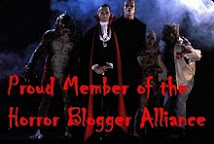Hammer Films' Dracula tales are most remembered as vehicles for Christopher Lee, so some people are surprised to find out that the first sequel to
Horror of Dracula was a film in which Dracula is already dead, Lee did not appear, and a rather unintimidating little man named Baron Meinster serves as the main masculine vampire. Alas, it's all true. The film in question is Hammer's 1960 vampi-rama
The Brides of Dracula, in which Peter Cushing picks up where the 1958 film left off and takes on a new vampire threat, none of whom are actually wed to the Count.
The film primarily follows the exploits of a French
babe schoolteacher named Marianne (played by Yvonne Monlaur, who is actually the daughter of a Russian count), who takes a job in the Transylvanian countryside (because, well, WHO WOULDN'T?) and ends up spending the night in a big old castle where a mother has her son chained up by the ankle. To some that might seem like a relatively normal night in Transylvania - I've seen enough horror flicks to know someone is always chained up to something - but the pure and innocent Marianne is pretty freaked out and this, along with the craziness of the house's servant (Freda Jackson, getting to play what's basically a female version of Renfield!), convinces Marianne that she's safer booking it through the forest than staying the night.

And that's when the hero returns in the form of Doctor Van Helsing, as played by the great Peter Cushing. Cushing would play "Van Helsing" five times for Hammer, but it's worth noting that he actually portrayed three different characters in five different films in three different timelines during his time with Hammer. This is (at least in Hammer's universe) the only continuation of the "original" version of Cushing asVan Helsing, while his performances in the Dracula films of the 1970s are relatives of this character. So, next time someone tells you Cushing played Van Helsing five times, you can prove them wrong by saying he only played this Van Helsing twice. Isn't that a great feeling?

Now back to the film, which strikes me as one of Hammer's more beautiful vampire films. The sets are pretty recognizable - we must remember that this was a relatively low budget studio and they did reuse plenty of their sets and props - but there's something vibrant and wonderful about their presentation by director Terence Fisher here. Horror of Dracula was not a dull film from a visual standpoint, but it seems Fisher attempted to cover up some of this film's issues with a little more color and a lot of feminine beauty. That's not a bad choice for a film that loses Christopher Lee and gains a looker like Monlaur, and the director's vision of the film helps The Brides of Dracula keep our attention for 85 minutes.

The tone of the film loses much of the romanticism that carried Hammer's first Dracula endeavor, and The Brides of Dracula certainly feels like a cheesy spin-off at times. A few of the sequences with the vampire women - especially the ones in which they interact with Jackson's manic servant/familiar - play out in bizarre fashion, yet the film strides forward with confidence that the viewer will forgive some of the sillier bits. There are moments when the film could have lost me - like an unconventional scene in which Van Helsing deals with a bite wound to his own neck - but there's something to be said for this film's slightly random, slightly nightmarish approach to Marianne and Van Helsing's battle against evil.

The Brides of Dracula isn't the most dramatic vampire film from Hammer studios, and it's not even close to being the most unique. But it's an abstract vampire tale that hits me as a perfect diversion, a new chapter in a familiar story that enhances my appreciation of Fisher as a filmmaker, Cushing as an actor, and the whole of Hammer Studios as a titan of terror. The Brides of Dracula is widely forgotten, but it deserves more attention for its place in horror history and its unique relationship to the studio's other Dracula films.
















No comments:
Post a Comment